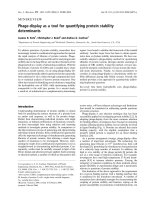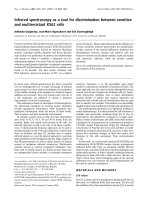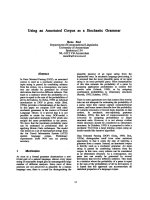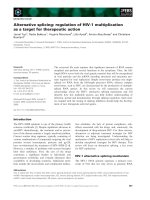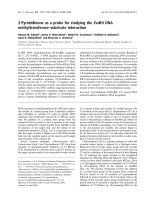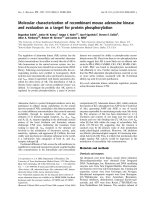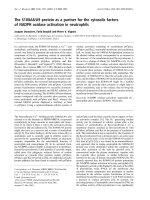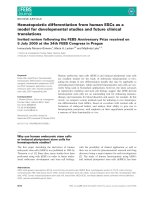Using treated human dentin as a scaffold for dental pulp stem cells to generate dentin like tissue
Bạn đang xem bản rút gọn của tài liệu. Xem và tải ngay bản đầy đủ của tài liệu tại đây (2.17 MB, 12 trang )
Human dental pulp stem cells cultured
onto dentin derived scaffold can regenerate
dentin-like tissue in vivo
Ha Le Bao Tran & Vu Nguyen Doan
Cell and Tissue Banking
International Journal for Banking,
Engineering and Transplantation
of Cells and Tissues Incorporating
Advances in Tissue Banking
ISSN 1389-9333
Cell Tissue Bank
DOI 10.1007/s10561-015-9503-z
1 23
Your article is protected by copyright and all
rights are held exclusively by Springer Science
+Business Media Dordrecht. This e-offprint
is for personal use only and shall not be selfarchived in electronic repositories. If you wish
to self-archive your article, please use the
accepted manuscript version for posting on
your own website. You may further deposit
the accepted manuscript version in any
repository, provided it is only made publicly
available 12 months after official publication
or later and provided acknowledgement is
given to the original source of publication
and a link is inserted to the published article
on Springer's website. The link must be
accompanied by the following text: "The final
publication is available at link.springer.com”.
1 23
Author's personal copy
Cell Tissue Bank
DOI 10.1007/s10561-015-9503-z
Human dental pulp stem cells cultured onto dentin derived
scaffold can regenerate dentin-like tissue in vivo
Ha Le Bao Tran • Vu Nguyen Doan
Received: 20 November 2014 / Accepted: 18 February 2015
Ó Springer Science+Business Media Dordrecht 2015
Abstract Regeneration of dentin tissues in the pulp
space of teeth serves the ultimate goal of preserving
teeth via endodontic approaches. In recent times,
many studies suggested that human dentin scaffolds
combined with dental stem cells was a potential
strategy for the complete dentin tissue regeneration. In
this study, human dental pulp stem cells (DPSCs) were
isolated and cultured. Dentin specimens were prepared
from human third molars and treated with ethylene
diamine tetra-acetic acid and citric acid to remove the
smear layer. Then, DPSCs were cultured onto human
treated dentin (hTD) and implanted in mouse model
for 4, 6 and 8 weeks. The resulting grafts were
assessed by hematoxylin and eosin stain and immunohistochemical stains. As a result, DPSCs were
supported and induced to regenerate of dentin-like
tissues which expressed specific dentin markers such
as dentin sialophosphoprotein and dentin matrix
protein 1 by combination with hTD in vivo. Furthermore, cells existed in the newly-formed dentin-like
tissues also expressed typical human mitochondria
antibodies, demonstrated that new tissues originated
from human. In conclusion, the obtain results extend
H. L. B. Tran (&) Á V. N. Doan
Department of Physiology and Animal Biotechnology,
Faculty of Biology, University of Science, Vietnam
National University at Ho Chi Minh City,
227 Nguyen Van Cu Street, Ward 4, District 5,
Ho Chi Minh City, Vietnam
e-mail:
hopefully newly-established therapy to apply in
endodontics and traumatic dental hard tissues.
Keywords Dentin Á Dental pulp Á Tissue
engineering Á Mesenchymal stem cells Á
Extracellular matrix protein
Introduction
Stem cell research has become a promising field for
tissue regeneration and implementation of regenerative medicine. Since the discovery and characterization of multipotent mesenchymal stem cells (MSCs)
from bone marrow, similar MSCs populations derived
from other tissues have now been characterized.
Postnatal stem cells have been isolated from a variety
of tissues including bone marrow, brain, skin, skeletal
muscle and the gastrointestinal tract (Baroffio et al.
1996; Slack 2000; Campagnoli et al. 2001; Gronthos
et al. 2003; Zannettino et al. 2008). Recent studies
have revealed the presence of adult stem cells in dental
tissues (Handa et al. 2002; Huang et al. 2008;
Rodrı´guez-Lozano et al. 2011). They are described
as multipotent stem cells, capable of self-renewal and
differentiation into various cell types, such as
osteocytes, adipocytes, chondrocytes, cementoblasts,
odontoblasts and neural cells (Gronthos et al. 2000,
2002; Batouli et al. 2003; Kamata et al. 2004).
Adult dental pulp contains a heterogeneous population of cells, including fibroblasts, nerve cells,
123
Author's personal copy
Cell Tissue Bank
undifferentiated mesenchymal cells or dental pulp
stem cells (DPSCs), vascular cells. DPSCs are often
found in highly vascularized sites and collected from
the pulp tissue of clinically extracted human teeth by
various isolation methods (Huang et al. 2006). These
cells are expanded and expressed a heterogeneous
assortment of markers associated with MSCs. Besides,
DPSCs also express nestin and GFAP, which are
molecules related to the neural crest-cell origin of the
dental pulp (Lovschall et al. 2007). DPSCs are capable
of differentiating into neuron-like cells, odontoblastlike cells, osteoblasts, chondrocytes, adipocytes,
smooth and skeletal muscle cells (d’Aquino et al.
2007; Graziano et al. 2008). In particular, the
importance of DPSCs is able to differentiate and
secrete a matrix that produces osteogenesis and
dentinogenesis in vitro and in vivo. Furthermore,
DPSCs are potentially superior to other types of adult
stem cell are extraction routinely throughout life. Even
of more importance is the ability to secure DPSCs at a
young age and store it for the future usage. A
personalized stem cell can then be created from DPSC
without using procedures that may cause ethical
concerns (Batouli et al. 2003; Shi and Gronthos
2003; Miura et al. 2003).
Many kinds of synthetic and natural polymers have
been utilized for dentin tissue engineering. However,
few were able to regenerate the complete dentin tissue.
Dentin, which is a mineral tissue, is included
approximately 70 % hydroxyapatite and collagenous
and noncollagenous organic matrix components.
Dentin is formed by odontoblasts which establish a
continuous single layer along the peripheral dental
pulp tissue and deposit new layers of dentin throughout human life (Thesleff and Vaahtokari 1992; Stern
et al. 2009). Dentin is an essential component for
dental tissue engineering because makes up most of
the tooth structure. Moreover, the soluble proteins of
human dentin are bioactive proteins considered to be
necessary for dentinogenesis (Chun et al. 2011; Li
et al. 2011). Scaffolds from natural dentin, which were
collected freely and eliminated as medical waste, have
been suggested to be useful in dentin regeneration
(Lluch et al. 2009).
Previous researches demonstrated that hDPSCs
cultured on mechanically and chemically treated
dentin appeared to establish an odontoblast-like
morphology, with cytoplasmic processes extending
into dentinal tubules. Their results suggest that
123
isolated hDPSCs may differentiate into odontoblasts
on dentin in vitro (Huang et al. 2006). However, it is
not clear whether dentin scaffolds induce hDPSCs to
regenerate the complete dentin tissue. Therefore, in
this study we combined human treated dentin (hTD)
and cultured DPSCs to assess regeneration of human
dentin-like tissue in vivo.
Materials and methods
Isolation and culture of human dental pulp stem
cells (DPSCs)
DPSCs were isolated and cultured followed protocol
described previously (Tran et al. 2011). In brief, the
human third molars were obtained from healthy
donors at the Maxillofacial Faculty, under the
approval of the Ethical Committee of Ho Chi Minh
City Medicine and Pharmacy University, and stored in
Dulbecco’s modified Eagle’s medium (DMEM,
Sigma, St. Louis, MO) supplemented with antibiotics
(300 U/ml penicillin and 300 mg/ml streptomycin,
Sigma). Small fragments of dental pulp tissues were
seeded onto 35-mm dishes (NUNC, Roskilde, Denmark) with Dulbecco’s modified Eagle’s medium/
nutrient mixture F-12 Ham medium (DMEM/F12,
Sigma) supplemented with 10 % fetal bovine serum
(FBS, Sigma) and maintained in 5 % CO2 at 37 °C.
The fourth passage cells were used for following
studies.
Characterization of cell proliferation
The DPSCs at the fourth passage were seeded with a
density of 103 cells/well of 96-well culture dish
(NUNC) with culture medium. Cell density was
identified everyday, continuously in 10 days. Growth
curve was determined from counted cell quantity. To
assess the time of duplication or doubling time (DT),
the following equation was applied: DT = CT/log
N/N0 9 3.31, where CT = culture time, N = final
number of cells, N0 = initial number of cells (PieraVelazquez et al. 2002).
Cell-surface-marker characterization
The DPSCs at the fourth passage were detached and
identified specific surface antigen expression by flow
Author's personal copy
Cell Tissue Bank
cytometry. After the cells were harvested and
transferred, they were fixed for 15 min in 4 %
paraformaldehyde. The cells were incubated with
3 % bovine serum albumin and then with primary
antibodies (BD Biosciences) raised against CD44,
CD90, CD73, CD34, CD45, and HLA-DR for 1 h. The
cells were washed with wash buffer, and the secondary
antibody was added for 45 min at room temperature.
Finally, the cells were washed three times and
analyzed with a flow cytometer (FACSCalibur, BD
Biosciences).
Multilineage differentiation
The fourth passage cells were seeded into 35 mm dishes
and cultured until they reached subconfluence. After
that, cells were cultured in the adipogenesis medium
[DMEM/F12 medium containing 10 % FBS, 0.2 mM
indomethacin, 0.5 mM isobutyl-methylxanthine,
100 nM dexamethasone, 10 mM insulin, 100 U/ml
penicillin, and 100 mg/ml streptomycin (Sigma)] and
osteogenesis medium [DMEM/F12 medium containing
10 % FBS, 100 nM dexamethasone, 100 mM bglycerol phosphate and 50 lg/ml a-ascorbic acid
2-phosphate, 100 U/ml penicillin, and 100 mg/ml
streptomycin (Sigma)]. After 2–3 weeks of induction,
the cells were stained with oil red O or alizarin red to
evaluate adipogenesis and osteogenesis, respectively.
Nude mice. All in vivo experiments were carried out in
accordance with the ethical guidelines for Animal
Care and Use Committee of University of Medicine
and Pharmacy at Ho Chi Minh City. Nude mice were
divided into three groups including one experiment
group (hTD combined with DPSCs) and two control
groups (MTA combined with DPSCs and single hTD).
hTD and MTA scaffolds were soaked in culture
medium at 37 °C overnight. Then, DPSCs were
seeded onto scaffolds at density of 3 9 104 cells/
scaffold and incubated in 5 % CO2 at 37 °C for
3 days. Surgical operation was performed under deep
anesthesia. After 4, 6 and 8 weeks, Nude mice were
deeply anesthetized to collect all structures (one
experiment group and two control groups). Structures
were fixed with 10 % formaldehyde for 24 h at 4 °C
and stained with hematoxylin and eosin (H&E) stain
and immunohistochemical stains. Immunohistochemical antibodies included dentin matrix protein 1
(DMP-1), dentin sialophosphoprotein (DSPP) and
human mitochondria (Sigma).
Results
Isolation and culture of human dental pulp stem
cells (DPSCs)
Characterization of cell proliferation
Fabrication of human treated dentin
Dentin tissues were prepared from collected human
third molars after the pulp tissue had been removed to
obtain DPSCs. Periodontal tissues were completely
eliminated by using mechanical method. Dentin tissues
were cut into a cube shape (approximately 3 mm
long 9 2 mm wide 9 1 mm thick). Dentin specimens
were treated with 19 % citric acid (Sigma) for 1 min
and 17 % diamine tetra-acetic acid (EDTA) (Sigma) for
10 min to remove the smear layer (Tran et al. 2011).
hTDs were then sterilized by gamma radiation. Mineral
trioxide aggregate (MTA, Tulsa Dental Products,
Tulsa, OK) scaffolds were used as a control group.
After four times of subculturing, DPSCs strongly
proliferated from the second day to the seventh day,
peaked in the seventh day which was confluence, and
gradually decreased in some days after that (Fig. 1).
Cell-surface-marker characterization
Surface markers expressed on the DPCs at the fourth
passage were analyzed by flow cytometry. As a result,
the DPSCs strongly expressed markers CD44
(99.84 %), CD73 (99.77 %) and CD90 (97.34 %)
and lacked expression markers CD34 (0.42 %), CD45
(0.08 %), and HLA DR (0.18 %) (Fig. 2).
Regeneration of dentin-like tissue in vivo
Differentiation into adipocytes and osteoblasts
In order to prove the role of hTD scaffolds in induction
for regeneration of dentin tissue of DPSCs in vivo, we
subcutaneously implanted samples into the dorsum of
The DPSCs at the fourth passage were differentiated
into adipocytes and osteoblasts. The differentiation
was achieved after 14–21 days. After 21 days, the
123
Author's personal copy
Cell Tissue Bank
Furthermore, after three cultured days in vitro, DPSCs
began spreading onto hTD surface (Fig. 5b).
Regeneration of dentin-like tissue in vivo
Fig. 1 Growth curve of DPSCs
result of oil red O and alizarin red staining showed that
there were mineralized nodule (Fig. 3b) and lipid
droplets (Fig. 4b) formation inside the differentiated
cells.
Fabrication of human treated dentin
Based on results of SEM, dentin surface was readily
visible in all specimens as evidenced by lack of smear
layer and abundance of patent dentinal tubules (Fig. 5a).
Fig. 2 Flow cytometry analysis of the DPSCs
123
After surgical operation, all experimental mice
rehabilitated quickly. Their normally activities were
not affected by implanted materials. Based on results
of H&E stain, in the experiment group, there was the
formation of new tissues at 4, 6 and 8 weeks. Newlyformed tissue thickness and cell density increased
from 4 to 6 weeks. However, cell density did not
increase at 8 weeks. At 6 and 8 weeks, area adjacent to
hTD took form concentrated matrix and expand over
time. Furthermore, most cells were buried in concentrated matrix at 8 weeks (Fig. 6a–c). In the MTA
control group, only a thin dentin-like matrix layer was
formed on MTA scaffold surfaces at 8 weeks (no cells
were observed) (Fig. 6d). On the other hand, no new
tissue formed by using a hTD without DPSCs (single
hTD control group) at 4, 6 and 8 weeks (Fig. 6e).
Expression of DSPP and DMP-1 was detected in
the new tissues formed in hTDs at 4 (data not shown),
6 and 8 weeks (Fig. 6f–i). These results demonstrated
Author's personal copy
Cell Tissue Bank
Fig. 3 Result of differentiation into osteoblasts of the DPSCs. a Negative control, b the differentiated cells after being stained with
alizarin red. Images magnified: 9200
Fig. 4 Result of differentiation into adipocytes of the DPSCs. a Negative control, b the differentiated cells after being stained with oil
red O. Images magnified: 9400
that the newly-formed tissues were dentin-like tissues.
In order to demonstrate whether participation of the
implanted DPSCs induced to regenerate dentin-like
tissues, human mitochondria antibody, which only
responded to a human source, was used. All cells in
regenerated tissues were positive with human mitochondria antibody, proven that implanted DPSCs
participated in human dentin-like tissues regeneration
in vivo (Fig. 6j, k).
Discussion
Five types of human dental stem cells have been
isolated and characterized: DPSCs (Gronthos et al.
2000), stem cells from human exfoliated deciduous
teeth (SHED) (Miura et al. 2003), periodontal
ligament stem cells (PDLSCs) (Seo et al. 2004),
dental follicle progenitor cells (DFPCs) (Morsczeck
et al. 2005) and stem cells from apical papilla (SCAP)
(Sonoyama et al. 2008). Dental pulp, entrapped within
the ‘sealed niche’ of the pulp chamber, is an extremely
rich site for stem cells isolation. Dental pulp tissue has
been reported to contain MSC-like population referred
to as DPSCs (Gronthos et al. 2000). Several studies
have reported that DPSCs express MSC markers such
as CD10, CD13, CD29, CD44, CD59, CD73, CD90
and CD105, and do not express CD14, CD34, CD45,
HLA-DR. Furthermore, DPSCs are capable of differentiation into odontoblast-like cells, osteoblasts,
123
Author's personal copy
Cell Tissue Bank
Fig. 5 SEM of dentin surface. a Surfaces of dentin slices were treated, b DPSCs spreaded on hTD surface. Images magnified: 93000
(a), 91100 (b)
adipocytes, smooth and skeletal muscle cells
(dAquino et al. 2007; Karaoăz et al. 2009; Nakamura
et al. 2009).
In this study, we demonstrated that isolation of
human DPSCs by outgrowth method, allowed the
recovery of a population of dental MSCs, which
showed a notable proliferation potential, multipotency. Furthermore, DPSCs exhibited a DT of 54.38 h
which revealed that DPSCs have higher proliferation
capacities than bone marrow stem cells (BMSCs)
(61.2 h) and slower proliferation capacities than
umbilical cord stem cells (UCSCs) (24 h) and
adipocyte stem cells (ADSCs) (45.2 h) (Hass et al.
2011). In addition, our data also showed that, DPSCs
were expressed over 95 % positive for the CD44,
CD73 and CD90 antigens, less than 2 % of the
leucocyte marker CD45, the primitive haematopoietic
progenitor and endothelial cell marker CD34, the B
cell markers HLA-DR by flow cytometry analysis.
Until now, many materials have been used to create
scaffolds for dentin regeneration. However, few have
succeeded in obtaining complete dentin tissue (Li et al.
2011; Honda et al. 2007; Scheller et al. 2009).
Previous studies have demonstrated that hTD could
be a conformable scaffold for dental tissue engineering because of its non-immunogenicity, suitable
mechanical properties, and releasing dentinogenetic
factors. Previous studies also have shown that soluble
proteins extracted from dentin, such as DSPP, DMP-1,
proteoglycans (decorin and biglycan), as well as
growth factors such as TGF-b, bone morphogenic
123
Fig. 6 Histological results of regeneration of dentin-like tissue c
in vivo. a–c Formation of new dentin-like tissues at 4, 6 and
8 weeks, d only dentin-like matrix were formed on MTA
scaffold surfaces at 8 weeks, e no new tissue was formed on
single hTDs at 8 weeks. Regenerated tissues on hTD were
positive with DMP-1 and DSPP at 6 weeks (f, h) and 8 weeks
(g, i). Regenerated tissues and its cells were positive with human
mitochondria antibodies at 6 weeks (j) and 8 weeks (k)
protein (BMP), can regulate dentinogenesis and
mineral formation (Chun et al. 2011; Li et al. 2011;
Guo et al. 2009). In our experiment, we sterilized hTD
by gamma radiation. Gamma radiation is mainly used
for the sterilization of pharmaceuticals and biomaterials in graft. Results showed that hTD scaffolds
sterilized by gamma radiation remained high level of
bioactive protein such as TGF-b and DMP-1 (data not
shown).
EDTA, which is widely used in endodontic therapy,
is a chelating agent capable of removing inorganic
material to enlarge root canals, removing the smear
layer, and preparing the dentinal walls for better
adhesion of filling materials. The combined use of
EDTA and acid citric has been shown to be particularly effective for smear layer and debris removal
(Tran et al. 2011; Nakashima and Terata 2005; Huang
et al. 2006). The result of treatment removed
completely smear layer and exposed dentin tubules
on hTD surfaces. Besides, we demonstrated that
DPSCs could adhere and proliferate on hTDs in vitro
(Tran et al. 2011). This indicated that hTD had good
biocompatibility and supported cell growth.
Author's personal copy
Cell Tissue Bank
123
Author's personal copy
Cell Tissue Bank
Mineral trioxide aggregate (MTA) is biomaterial
that has been investigated for endodontic applications
since the early 1990s. MTA was first described in the
dental scientific literature in 1993 and was given
approval for endodontic use by the U.S. Food and
Drug Administration in 1998. MTA has been shown to
induce hard-tissue repair of exposed pulps in experimental animals and to generate a greater frequency of
dentin bridge formation than earlier materials (Lee
et al. 1993; Schmitt and Bogen 2001; Andelin et al.
2003).
hTD scaffolds seeded with DPSCs were implanted
into nude mice at the dorsum where non-affected
normal activities of experimental animals, nonpotential mineralization and abundant vasculargenesis. Implantation immediately after seeding DPSCs to
the hTD scaffolds did not perform because DPSCs
needed more time to adhere and spread on scaffold
surfaces. According to growth curve of DPSCs
(Fig. 2), the lag phase tended to be about 2 days for
culture meaning that DPSCs could start to proliferate
2 days after being seeded onto hTD scaffolds.
Furthermore, less than 3 days in vitro culture of
hTD/DPSCs also did not obtain satisfactory regenerated results; concurrently, 3 days in vitro culture were
proposed because risk of contamination for in vitro
culture likely increased with time (Li et al. 2011).
During the last years, several studies investigated
that hDPSCs formed multilayer and secreted extracellular matrix onto the treated dentin surface.
Furthermore, hTD potentially induced DPSCs to
establish an odontoblast-like morphology with a
cytoplasmic process extending into a dentinal tubule
after 14 days (Huang et al. 2006), 10 days (Shao et al.
2011) or 28 days (Neunzehn et al. 2014) in vitro.
Through an in vivo study, pieces of root canals of the
extracted teeth, containing collagen or PLA scaffolds
seeded with the autologous cryopreserved DPSCs,
were implanted into the fresh post-extraction socket of
the mini pig jaw. The results showed an odontoblastlike cell construct with an organic matrix formation on
the root canal wall surface of porcine teeth after 6 and
10 weeks. More specifically, the newly formed
odontoblastic-like cell layer lining along the existing
canal walls stained positive for DMP-1 antibody
(Kodonas et al. 2012).
In this study, implantable structures were evaluated
at 4, 6 and 8 weeks that identified growth and change
123
of newly-formed tissues. Mineralization of new
tissues occurred at the junction with hTD and
developed on the opposite side; similar to the natural
formation of human dentin. Specially, all hTD scaffolds and DPSCs derived from human; therefore this
study was step ahead in dental tissue engineering. Two
control groups lacked one of important elements (hTD
or DPSCs), therefore no regeneration of new tissues.
This suggested that hTD and DPSCs played essential
role in the regeneration of dentin-like tissues in vivo.
Histological examination of implanted DPSCs/hTD
structures showed that newly-formed tissues were
positive with two specific markers for dentin matrix
(DMP-1 and DSPP). During dentin formation, odontoblasts synthesize several noncollagenous proteins
and deposit into the dentin extracellular matrix. One of
these proteins is DSPP, which is believed to play a
regulatory role in the mineralization of reparative
dentin; it also serves as a specific marker for the
odontoblastic phenotype (Papagerakis et al. 2002).
Besides, DMP-1 is a multifunctional protein, prominent member of one category of non-collagenous
proteins and plays an essential role in biomineralization. More recently, DMP-1 was found to induce
cytodifferentiation of DPSCs into odontoblast-like
cells during dentinogenesis, indicating that it could act
as a morphogen with the potential to regenerate
dentin-like tissue and to form reparative dentin
(Toyosawa et al. 2004).
Results of our study indicated that hTD scaffolds
induced and supported DPSCs to secrete extracellular
matrix and regenerate dentin-like tissue. In addition,
cells of newly-formed tissues were positive with
human mitochondria; concurrently, no new tissue
formed by using single hTD, suggested that the seeded
DPSCs were essential role to participate in the
regenerated dentin-like tissues.
Conclusion
This research described the successful combination of
hTD and human DPSCs. This is one of potential
strategies for dentin-like tissue regeneration based on
tissue engineering principle.
Acknowledgments This research is funded by Vietnam
National University-Ho Chi Minh city under Grant number
B2012-18-11TÐ.
Author's personal copy
Cell Tissue Bank
Conflict of interest The authors declare that there is no personal or financial conflict of interests in the current research.
References
Andelin W, Shabahang S, Wright K (2003) Identification of
hard tissue after experimental pulp capping using dentin
sialoprotein (DSP) as a marker. J Endod 29:646–650
Baroffio A, Hamann M, Bernheim L, Bochaton-Piallat ML,
Gabbiani G, Bader CR (1996) Identification of selfrenewing myoblasts in the progeny of single human muscle
satellite cells. Differentiation 60:47–57
Batouli S, Miura M, Brahim J, Tsutsui TW, Fisher LW, Gronthos S, Robey PG, Shi S (2003) Comparison of stem cells
mediated osteogenesis and dentinogenesis. J Dent Res
82:976–981
Campagnoli C, Roberts IA, Kumar S, Bennett PR, Bellantuono
I, Fisk NM (2001) Identification of mesenchymal stem/
progenitor cells in human first-trimester fetal blood, liver,
and bone marrow. Blood 98:2396–2402
Chun SY, Lee HJ, Choi YA, Kim KM, Baek SH, Park HS, Kim
JY, Ahn JM, Cho JY, Cho DW, Shin HI, Park EK (2011)
Analysis of the soluble human tooth proteome and its
ability to induce dentin/tooth regeneration. Tissue Eng Part
A 17:181–191
d’Aquino R, Graziano A, Sampaolesi M, Laino G, Pirozzi G, De
Rosa A, Papaccio G (2007) Human postnatal dental pulp
cells co-differentiate into osteoblasts and endotheliocytes:
a pivotal synergy leading to adult bone tissue formation.
Cell Death Differ 4:1162–1171
Graziano A, d’Aquino R, Laino G, Proto A, Giuliano MT, Pirozzi G, De Rosa A, Di Napoli D, Papaccio G (2008) Human
CD34? stem cells produce bone nodules in vivo. Cell Prolif
41:1–11
Gronthos S, Mankani M, Brahim J, Robey PG, Shi S (2000)
Postnatal human dental pulp stem cells (DPSCs) in vitro
and in vivo. Proc Natl Acad Sci 97:13625–13630
Gronthos S, Brahim J, Li W, Fisher LW, Cherman N, Boyde A,
DenBesten P, Robey PG, Shi S (2002) Stem cell properties
of human dental pulp stem cells. J Dent Res 81:531–535
Gronthos S, Zannettino AC, Hay SJ, Shi S, Graves SE, Kortesidis A, Simmons PJ (2003) Molecular and cellular characterisation of highly purified stromal stem cells derived
from human bone marrow. J Cell Sci 116:1827–1835
Guo WH, He Y, Zhang XJ, Lu W, Wang CM, Yu H, Liu Y, Li Y,
Zhou Y, Zhou J, Zhang M, Deng Z, Jin Y (2009) The use of
dentin matrix scaffold and dental follicle cells for dentin
regeneration. Biomaterials 30:6708–6723
Handa K, Saito M, Tsunoda A, Yamauchi M, Hattori S, Sato S,
Toyoda M, Teranaka T, Narayanan AS (2002) Progenitor
cells from dental follicle are able to form cementum matrix
in vivo. Connect Tissue Res 43:406408
Hass R, Kasper C, Boăhm S, Jacobs R (2011) Different populations and sources of human mesenchymal stem cells
(MSC): a comparison of adult and neonatal tissue-derived
MSC. Cell Commun Signal 9:12
Honda MJ, Tsuchiya S, Sumita Y, Sagara H, Ueda M (2007) The
sequential seeding of epithelial and mesenchymal cells for
tissue-engineered tooth regeneration. Biomaterials
28:680–689
Huang GT, Sonoyama W, Chen J, Park SH (2006) In vitro
characterization of human dental pulp cells: various isolation methods and culturing environments. Cell Tissue
Res 324:225–236
Huang GT, Sonoyama W, Liu Y, Liu H, Wang S, Shi S (2008)
The hidden treasure in apical papilla: the potential role in
pulp/dentin regeneration and bioroot engineering. J Endod
34:645–651
Kamata N, Fujimoto R, Tomonari M, Taki M, Nagayama M,
Yasumoto S (2004) Immortalization of human dental
papilla, dental pulp, periodontal ligament cells and gingival
fibroblasts by telomerase reverse transcriptase. J Oral
Pathol Med 33:417423
Karaoăz E, Dogan BN, Aksoy A, Gacar G, Akyuăz S, Ayhan S,
Gencá ZS, Yuăruăker S, Duruksu G, Demircan PC, Sariboyaci
AE (2009) Isolation and in vitro characterisation of dental
pulp stem cells from natal teeth. Histochem Cell Biol
133:95–122
Kodonas K, Gogos C, Papadimitriou S, Kouzi-Koliakou K,
Tziafas D (2012) Experimental formation of dentin-like
structure in the root canal implant model using cryopreserved swine dental pulp progenitor cells. J Endod
38:913–919
Lee SJ, Monsef M, Torabinejad M (1993) Sealing ability of a
mineral trioxide aggregate for repair of lateral root perforations. J Endod 19:541–544
Li R, Guo W, Yang B, Guo L, Sheng L, Chen G, Li Y, Zou Q,
Xie D, An X, Chen Y, Tian W (2011) Human treated dentin
matrix as a natural scaffold for complete human dentin
tissue regeneration. Biomaterials 32:4525–4538
Lluch AV, Fernandez AC, Ferrer GG, Pradas MM (2009)
Bioactive scaffolds mimicking natural dentin structure.
J Biomed Mater Res B Appl Biomater 90:182–194
Lovschall H, Mitsiadis TA, Poulsen K, Jensen KH, Kjeldsen AL
(2007) Coexpression of Notch3 and Rgs5 in the pericytevascular smooth muscle cell axis in response to pulp injury.
Int J Dev Biol 51:715–721
Miura M, Gronthos S, Zhao M, Lu B, Fisher LW, Robey PG, Shi
S (2003) SHED: stem cells from human exfoliated deciduous teeth. Proc Natl Acad Sci 100:5807–5812
Morsczeck C, Gotz W, Schierholz J, Zeilhofer F, Kuhn U,
Mohl C (2005) Isolation of precursor cells (PCs) from
human dental follicle of wisdom teeth. Matrix Biol
24:155–165
Nakamura S, Yamada Y, Katagiri W, Sugito T, Ito K, Ueda M
(2009) Stem cell proliferation pathways comparison between human exfoliated deciduous teeth and dental pulp
stem cells by gene expression profile from promising
dental pulp. J Endod 35:1536–1542
Nakashima K, Terata R (2005) Effect of pH modified EDTA
solution to the properties of dentin. J Endod 31:47–49
Neunzehn J, Weber MT, Wittenburg G, Lauer G, Hannig C,
Wiesmann HP (2014) Dentin-like tissue formation and
biomineralization by multicellular human pulp cell spheres
in vitro. Head Face Med 10:25
Papagerakis P, Berdal A, Mesbah M, Peuchmaur M, Malaval L,
Nydegger J (2002) Investigation of osteocalcin, osteonectin, and dentin sialophosphoprotein in developing
human teeth. Bone 30:377–385
123
Author's personal copy
Cell Tissue Bank
Piera-Velazquez S, Jimenez SA, Stokes D (2002) Increased life
span of human osteoarthritic chondrocytes by exogenous
expression of telomerase. Arthritis Rheum 46:683–693
Rodrı´guez-Lozano FJ, Bueno C, Insausti CL, Meseguer L,
Ramı´rez MC, Blanquer M, Marı´n N, Martı´nez S, Moraleda
JM (2011) Mesenchymal stem cells derived from dental
tissues. Int Endod J 44:800–806
Scheller EL, Krebsbach PH, Kohn DH (2009) Tissue engineering: state of the art in oral rehabilitation. J Oral Rehabil
36:368–389
Schmitt D, Bogen G (2001) Multifaceted use of ProRoot MTA
root canal repair material. Pediatr Dent 23:326–330
Seo BM, Miura M, Gronthos S, Bartold PM, Batouli S, Brahim
J, Young M, Robey PG, Wang CY, Shi S (2004) Investigation of multipotent postnatal stem cells from human
periodontal ligament. Lancet 364:149–155
Shao MY, Fu ZS, Cheng R, Yang H, Cheng L, Wang FM, Hu T
(2011) The presence of open dentinal tubules affects the
biological properties of dental pulp cells ex vivo. Mol Cells
31:65–71
Shi S, Gronthos S (2003) Perivascular niche of postnatal mesenchymal stem cells in human bone marrow and dental
pulp. J Bone Miner Res 18:696–704
Slack JM (2000) Stem cells in epithelial tissues. Science
287:1431–1433
123
Sonoyama W, Liu Y, Yamaza T, Tuan RS, Wang S, Shi S (2008)
Characterization of the apical papilla and its residing stem
cells from human immature permanent teeth: a pilot study.
J Endod 34:166–171
Stern MM, Myers RL, Hammam N, Stern KA, Eberli D,
Kritchevsky SB, Soker S, Van Dyke M (2009) The influence of extracellular matrix derived from skeletal muscle
tissue on the proliferation and differentiation of myogenic
progenitor cells ex vivo. Biomaterials 30:2393–2399
Thesleff I, Vaahtokari A (1992) The role of growth factors in
determination and differentiation of the odontoblastic cell
lineage. Proc Finn Dent Soc 88:357–368
Toyosawa S, Okabayashi K, Komori T, Ijuhin N (2004) mRNA
expression and protein localization of dentin matrix protein
1 during dental root formation. Bone 34:124–133
Tran LBH, Doan NV, To MQ, Phan KN, Hoang TH, Hoang
DBT, Dang VNM, Nguyen TT (2011) Study on culture of
human dental pulp stem cells to apply in tissue engineering.
J Biomim Biomater Tissue Eng 11:13–20
Zannettino AC, Paton S, Arthur A, Khor F, Itescu S, Gimble JM,
Gronthos S (2008) Multipotential human adipose-derived
stromal stem cells exhibit a perivascular phenotype in vitro
and in vivo. J Cell Physiol 214:413–421
